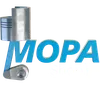INSTRUCTION Documents and Media for Engines
Documents and media is the article category that consolidates all technical INSTRUCTION content required to operate, maintain, and overhaul engines. This includes service manuals, parts catalogs, exploded drawings, torque charts, calibration files for control units, service bulletins, commissioning checklists, and training videos. While intangible, these assets act as a functional component in the engine ecosystem: they translate engineering intent into precise, repeatable actions on the hardware. For shipowners, operators, and purchasers, robust documentation is the difference between a compliant, efficient, safe installation and an engine exposed to avoidable risk.
Technical function of INSTRUCTION documents and media in marine and diesel engines
INSTRUCTION documents and media serve as the operational logic for technicians working on a marine engine or diesel engine. They specify tolerances, clearances, torques, and sequences—e.g., liner protrusion values, valve lash settings, injector clamp torques, and cylinder head tightening patterns. They also include control data and calibration media that ensure the ECU/ECM applies correct fuel maps, ignition curves (for gas engines), and protective limits. When paired with OEM parts, these instructions ensure fit, form, and function align with the engine design so that combustion quality, emissions, and thermal balance remain within specification.
In day-to-day practice, INSTRUCTION marine engine procedures guide safe start-up, warm-up, and shutdown; cooling system venting; turbocharger balancing and run-in; and lube oil flushing criteria. INSTRUCTION diesel engine content defines fuel injection timing windows, bearing crush checks, piston ring orientation, and cylinder liner wear limits, enabling consistent performance and protecting assets during both scheduled and corrective maintenance. Digital media further enhances accuracy through 3D exploded views, QR-coded part references, and update notifications, reducing ambiguity on the workshop floor.
- · Verified procedures and torque/clearance values
- · Serial-number-aligned parts catalogs and exploded diagrams
- · ECU calibration files and parameter sets with traceable revisions
- · Safety instructions and lockout/tagout steps tailored to the engine
- · Commissioning checklists and test protocols for sea trials
- · Service bulletins highlighting supersessions and updated limits
- · Multi-format access (PDF, CAD views, video) for field use
- · Change control and versioning for audit-ready compliance
Why INSTRUCTION documents and media are critical for reliable engine operation
Engines are sensitive to assembly accuracy, calibration integrity, and procedural discipline. If instructions are outdated or missing, small deviations compound quickly: a misapplied torque on a main bearing cap can accelerate wear and oil film collapse; an incorrect injector shim can alter spray geometry, raise peak pressures, and deteriorate emissions; a misplaced gasket or reversed piston ring can elevate blow-by and oil consumption. In gas engines, incorrect ignition maps increase detonation risk; in diesel engines, errors in injection timing or valve clearance reduce efficiency and raise exhaust temperature, threatening turbine life.
Beyond performance, correct INSTRUCTION content safeguards personnel and assets. It embeds safety barriers—purging procedures, isolation steps, hot-work criteria, and test checks—reducing incident probability. It also underpins regulatory compliance: class approvals, recordkeeping for planned maintenance systems (PMS), and evidence for statutory surveys all rely on accurate, updated documentation. Over the service life, this precision translates into longer component life, predictable overhaul intervals, and reduced unplanned downtime.
Advantages of OEM spare parts aligned with INSTRUCTION documents and media
Using OEM parts together with the correct INSTRUCTION materials produces a consistent technical baseline. Dimensions, materials, and coatings described in the documents match the components delivered, so torque-angle methods produce proper preload, sealing systems meet leakage targets, and calibration values correspond to measured sensor behaviors. This alignment reduces troubleshooting time and the need for rework, directly improving availability.
From a budget perspective, accurate INSTRUCTION OEM parts combinations shorten maintenance windows and minimize collateral damage caused by incorrect fits or speculative adjustments. Technicians can prepare kitted work orders, anticipate tool needs, and execute with confidence when procedures, drawings, and parameter sets are in sync with the components on hand. The result is a lower total cost of ownership through fewer repeat interventions and stable fuel and lube oil consumption profiles.
INSTRUCTION OEM parts synergy for performance, safety, and lifecycle
When the instruction set, measurement limits, and calibration media correspond precisely to the components installed, engines return to service faster and operate closer to design efficiency. Clear acceptance criteria—bearing clearances, liner wear steps, turbocharger run-out limits—are actionable, reducing subjective calls and safety risk. This synergy also supports data-driven maintenance, allowing operators to trend wear and plan overhauls with higher confidence.
MOPA: fast, high-quality, and secure supply of OEM parts and INSTRUCTION materials
MOPA is an experienced and reliable partner for OEM spare parts in the Documents and media category. We support purchasers and technical teams with rapid sourcing of OEM parts for diesel and gas engines, accompanied by the INSTRUCTION documents and media required for safe installation and commissioning. Our processes emphasize speed, quality, and security: traceable supply chains, document version control, and precise cross-referencing to engine types and serial ranges ensure that what arrives on board matches what the procedure specifies.
Whether you operate a coastal fleet or deep-sea vessels, MOPA helps align INSTRUCTION marine engine procedures and calibration files with the hardware you install. That alignment reduces risk during critical path jobs—top-end overhauls, turbocharger exchanges, fuel system upgrades—and supports compliance with class and flag requirements.
Conclusion: INSTRUCTION documents and media that protect engine performance
INSTRUCTION Documents and media transform complex engine designs into safe, efficient, repeatable work. When paired with OEM parts, they deliver predictable performance, longer service life, and controlled maintenance budgets. Partnering with MOPA ensures fast, secure access to the right components and the documentation that keeps diesel and gas engines operating within specification.

